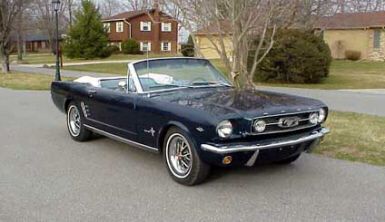
SAN FRANCISCO: The Mustang was an instant hit. By the end of the first model year and a
half (they were introduced in mid-1964) Mustangs had proven to be the perfect car for well
over a half-a-million people. In fact, if one was considering buying a car at the time and
didn't need a six-passenger sedan or a wagon, a Mustang was probably near the top of the
list. There was a hardtop, a convertible, and a new fastback coupe with a fold down rear
seat. The car could be ordered as a six-cylinder econo-car, an easy to drive shop-hopper
with power steering and brakes, a rip-snortin' street scrapper, or any combination
thereof. And the price was only a little more than a deluxe compact.
For 1966, there were few changes. The grille was cleaned up a bit and
the funny little chrome "scoop" screwed to the back of the side depression on
cars that weren't equipped with pin-striping, made way for a three-pronged spear thingie.
The hotter standard V-8 dropped to 210 h.p. though you still could order the 271 horse,
solid-lifter performance mill.
The big news for '66 was a disc brake option and the GT package. The
Mustang GT versions contained all of the performance options available as well as some
nifty stripes down the sides, fog lights up front and louvered exhaust ports in the rear
pan. Options were the 271 motor and the first series of styled steel wheels (like those on
the featured car).
Considered by some collectors as the last REAL Mustang, the '66 has the
same trim profile and simple design features of the original car. Each year that passed
from 1967 on found the Mustang bigger and styled more radically until it was replaced by
the smaller Mustang II in 1974.
This Nightmist Blue '66 Mustang is equipped with the 200 h.p. 289, two
barrel V-8, Cruise-a-matic, power steering, and standard drum brakes. Since over half of
the Mustangs came with similar options, this car is perfect for a "Behind The
Wheel" test drive.
DRIVING THE 1966 MUSTANG
This was the first time I had been behind the wheel of one of these
since high school. I was surprised to find it so comfortable to sit in and easy to drive.
Considering that the seatback rake has no adjustment and there is no tilt wheel, I fit
just great. The wheel is at just the right angle and the left arm naturally falls
comfortably on the windowsill. You still have to reach for the ignition and to adjust the
radio, but everything else is right there.
A twist of the key brings the growling 289 to life. These little mills
rev quite freely and will zip right up to red line before you know it. A four-barrel
speeds things up a bit, but the standard 2V version is plenty fast enough. Click the floor
mounted, T-handle shifter into drive and we're off in a flash. These mid-'60s
Cruis-o-matics have two drive positions. One gives you all three gears, the other only the
top two. I'm not exactly sure what the two-speed mode is for, though a friend from the
east said something about snow and slush. We Californians usually used all three . .
.waa-hoo!
By today's standards, these cars are real snappy. Lots of bottom end
oomph and just about when you're about to run out of valve train - wham - there's the next
gear. And yes, I know there are a bunch of engineering types that can show me facts and
figures proving that a late model 16-valve twin-cammer will blow a 200 horse Mustang away
but I'd swear the 'Stang is faster!
On the road, this pony feels OK. The Mustang has a lower center of
gravity than its compact contemporaries so it stays pretty flat in corners, yet isn't too
stiff to provide a fairly smooth ride. Remember that this isn't a restored car - it's an
old original with new shocks and front-end bushings. Very impressive.
Convertibles from this era tend to shake, rattle, and roll as they get
up in age. This Mustang had recent attention and a number of rubber seals replaced so it
felt tight and relatively rattle-free. On the down side were the standard drum brakes.
They stopped the car, but they needed a good push and took their time about it. One could
learn to use them safely but I'd opt for a set of power discs.
Though this is too valuable a car to subject to the rigors of everyday
traffic, it would be perfectly suitable and completely enjoyable to use as a daily driver.
Just another case of not being able to have your cake and eat it too. By Rick Feibusch
© AutoWire.Net - San Francisco

Byline: By Rick Feibusch © AutoWire.Net - San Francisco
Column Name: Classic Drive
Topic: 1966 Mustang Convertible
Word Count: 780
Photo Caption: 1966 Mustang Convertible
Photo Credits: D. Stribling
Series #: 1999 - 39


|
